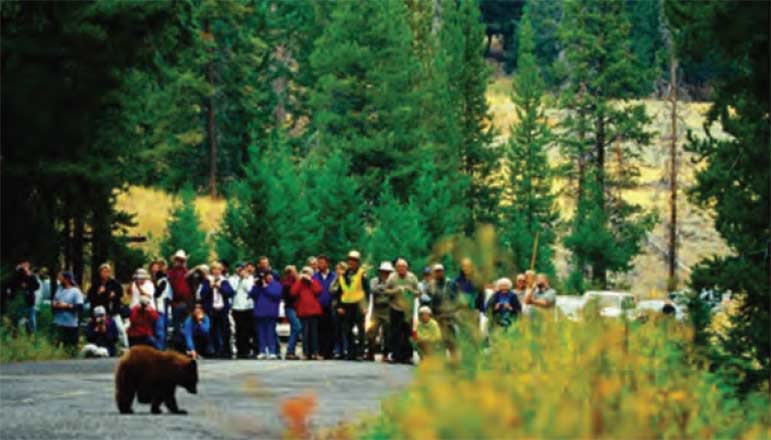
Yellowstone National Park managers are looking for ways to more effectively deliver safety messages about watching bears, wolves and other wildlife at roadside traffic jams.
Most visitors to Yellowstone National Park rank the chance to see a grizzly bear at or near the top of their vacation wish lists. But park managers struggle with how to best keep humans and bruins safe when crowds gather to view wildlife along the roadside.
When it comes to educating visitors about the risks and rules of watching bears, it turns out the most effective communication method is the one used least often.
That’s what University of Wyoming sociology professor Patricia Taylor learned when she conducted a wide-ranging 2013 survey that tested visitor knowledge of wildlife safety, and asked where they got their information.
Visitors who received an oral explanation from a park ranger were “much more likely” to correctly remember safety advice and regulations than those who got information from any other means, Taylor learned. Yet that was the method of communication encountered by the fewest respondents.
“The public has high regard for rangers, which is probably one reason why oral explanation is important,” Taylor said in October when discussing her findings at Mammoth Hot Springs during the 12th Biennial Scientific Conference on the Greater Yellowstone Ecosystem.
As part of an increased effort to learn more about visitor behavior and preferences, the National Park Service asked Taylor and the Wyoming Survey and Analysis Center to study what visitors knew about wildlife safety, and how they learned it.
That knowledge is important because Yellowstone sees nearly 1,000 traffic jams each summer where motorists stop their cars and wander around to watch and photograph bears, wolves and other animals, Taylor said.
Managing the crowd is the preferred method over managing individual bears, but rangers can’t be everywhere. So figuring out how to best deliver bear safety information is a key goal for the Park Service, she said.
“A roadside bear jam can create an almost carnival-like atmosphere,” Taylor said. “And the bear jam itself holds social meaning for visitors. It’s part of a shared ‘wilderness experience.'”
Taylor’s survey looked at bear safety messages delivered by written materials like the park newsletter given to vehicles upon entry, campground flyers, the Yellowstone website and warning signs, as well as oral explanations from rangers.
She found that visitors who received oral explanations were “much more likely” to remember correct information, and in fact, “only the oral explanation proved to be significantly related to knowledge of wildlife viewing and bear behavior.”
About half of those surveyed thought it was OK to get close to bears, and believed that bears would not be disturbed by people approaching, Taylor said.
In general, women were more likely to agree with park policies than men, and women were much less likely to take risks around animals, she found.
Those who traveled a long distance to visit Yellowstone were generally less likely to agree with park policies and general scientific findings, Taylor said.
“If they received an oral explanation, they were more likely to agree with park policy,” she said.
Taylor said it’s important to post signs and hand out flyers, but “by giving only written materials, the visitor is not getting that personal interaction, so there is a risk of not getting the message across.”
“Using rangers to enhance personal contact with visitors should be considered,” she said.
Contact Ruffin Prevost at 307-213-9818 or ruffin@yellowstonegate.com.
